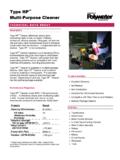Transcription of Copy of OSHA Regulation 1910.269 Part J – Live …
1 F:\Office 97\Flyers\ copy of osha Regulation copy of osha Regulation part J live Line Tools (j) " live -line tools." (j)(1) "Design of tools." live -line tool rods, tubes, and poles shall be designed and constructed to withstand the following minimum tests: .. (j)(1)(i) (j)(1)(i) 100,000 volts per foot (3281 volts per centimeter) of length for 5 minutes if the tool is made of fiberglass-reinforced plastic (FRP), or (j)(1)(ii) 75,000 volts per foot (2461 volts per centimeter) of length for 3 minutes if the tool is made of wood, or (j)(1)(iii) Other tests that the employer can demonstrate are equivalent. Note: live -line tools using rod and tube that meet ASTM F711-89, Standard Specification for Fiberglass-Reinforced Plastic (FRP) Rod and Tube Used in live -Line Tools, conform to paragraph (j)(1)(i) of this section. (j)(2) "Condition of tools." (j)(2)(i) Each live -line tool shall be wiped clean and visually inspected for defects before use each day. (j)(2)(ii) If any defect or contamination that could adversely affect the insulating qualities or mechanical integrity of the live -line tool is present after wiping, the tool shall be removed from service and examined and tested according to paragraph (j)(2)(iii) of this section before being returned to service.
2 (j)(2)(iii) live -line tools used for primary employee protection shall be removed from service every 2 years and whenever required under paragraph (j)(2)(ii) of this section for examination, cleaning, repair, and testing as follows: (j)(2)(iii)(A) Each tool shall be thoroughly examined for defects.. (j)(2)(iii)(B) (j)(2)(iii)(B) If a defect or contamination that could adversely affect the insulating qualities or mechanical integrity of the live -line tool is found, the tool shall be repaired and refinished or shall be permanently removed from service. If no such defect or contamination is found, the tool shall be cleaned and waxed. (j)(2)(iii)(C) The tool shall be tested in accordance with paragraphs (j)(2)(iii)(D) and (j)(2)(iii)(E) of this section under the following conditions: (j)(2)(iii)(C)(1) After the tool has been repaired or refinished; and (j)(2)(iii)(C)(2) After the examination if repair or refinishing is not performed, unless the tool is made of FRP rod or foam-filled FRP tube and the employer can demonstrate that the tool has no defects that could cause it to fail in use.
3 (j)(2)(iii)(D) The test method used shall be designed to verify the tool's integrity along its entire working length and, if the tool is made of fiberglass-reinforced plastic, its integrity under wet conditions. (j)(2)(iii)(E) The voltage applied during the tests shall be as follows: (j)(2)(iii)(E)(1) 75,000 volts per foot (2461 volts per centimeter) of length for 1 minute if the tool is made of fiberglass, or (j)(2)(iii)(E)(2) 50,000 volts per foot (1640 volts per centimeter) of length for 1 minute if the tool is made of wood, or (j)(3) Other tests that the employer can demonstrate are equivalent. Note: Guidelines for the examination, cleaning, repairing, and in-service testing of live -line tools are contained in the Institute of Electrical and Electronics Engineers Guide for In-Service Maintenance and Electrical Testing of live -Line Tools, IEEE Std. 978-1984. This osha Regulation taken from 29 CFR part 1910 . Found at
